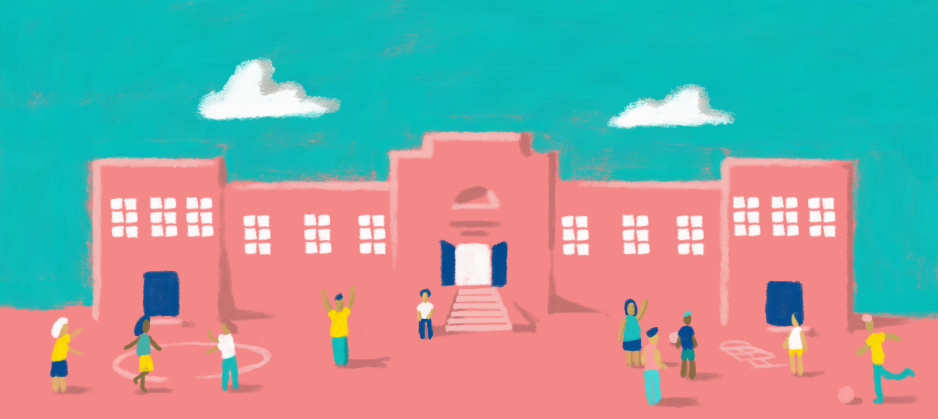
Dear Community Member,
As schools gear up to welcome students back for full-time classes around the province, I know that many North Vancouver families are feeling simultaneously anxious and relieved (to varying extents of each) at the prospect of sending their children back-to-school. It is reasonable for parents to want to know that their children will be safe at schools while also recognizing that schools are so much more than education — they’re also critical to the development of children and teens as well as important resources for families.
Back-to-School in North Vancouver
You can now find the approved local back-to-school plan for North Vancouver School District 44 online. Students will be placed in learning groups of no more than 30 people in all grades, achieving substantially smaller learning groups than the Ministry of Education and Public Health Officer allows. High school schedules will be based on a quarter timetable system and a blend of in-class and online learning will be used in Grades 10, 11, and 12.
The hybrid model used in the spring of 2020 didn’t work for everyone and left many students, particularly some of our most vulnerable students, behind. At the same time, I’ve also heard from many parents who would like to see an online learning option that doesn’t disconnect children from their schools entirely. I’m grateful to those parents who have reached out to me with their feedback as it has enabled my advocacy for you through the channels available to me.
On August 26, Minister of Education Rob Fleming announced that the Ministry of Education has given school districts the flexibility and certainty to find options that work for families. This includes the authority for school boards to be flexible and work with families to provide remote learning options that keep children connected to their regular school communities, as well as the tools they need to increase their existing programs (such as distributed learning) to meet demand.
School districts will be issued $101 million in additional one-time funding in September to support investments in enhanced safety and cleaning protocols, purchases of PPE, and further support remote learning for the families that need it.
School districts will contact all families to confirm if their child is attending school class, or if they require a remote learning option. Students are encouraged to re-join their classmates in school, but families may also choose to enrol in distributed learning (DL) if they are in high school, opt for a transitional online program if they are in elementary school, or be home-schooled.
Click here to review NVSD 44’s FAQs.
How does BC’s plan keep my child safe?
In the context of public health orders banning gatherings of 50 people or more, observant community members might wonder why school environments will tolerate learning groups of as large as 120 students with reduced physical distancing (less than 2m). While many School Districts like North Vancouver are in fact finding innovative scheduling solutions that enable learning groups that are far smaller (30 people), this question has been raised often enough that it deserves an effort to address.
In the COVID-19 era, every activity that we participate in sadly carries risk. Extended self-isolation would keep each of us very safe from COVID-19, for instance, but increases other health risks relating to declining mental health that can become debilitating and even deadly. Domestic violence can also increase during lock downs and overdose deaths have skyrocketed during the pandemic. Dr. Bonnie Henry and her team of public health officials aim to balance the risk of catching COVID-19 with the negative impacts caused by our responses to the disease.
Returning children to their schools and classes is an extremely important part of this balance. Keeping children out of school away from learning and socialization also carries a risk of serious negative consequences. Dr. Bonnie Henry has said that governments and families need to make choices and changes to enable the return of children to schools.
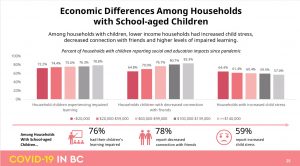 Image: Impact of school closures on kids.
Image: Impact of school closures on kids.
Public Health Orders generally ban gatherings of over 50 people, but this is not a magic number. A person is not protected against COVID-19 in a group of 49 people and then suddenly at high risk of catching it in a group of 51. Fifty was chosen based on the ability of public health officials to perform high quality contact tracing within a reasonable time-frame if a positive case is detected and is focused on one-time events where where control measures (also referred to as “layers of protection”) may be hard to implement.
Further, as economic and social activity has gradually increased, so has the importance of prompt and complete contact tracing to provide clinical support to those who may have been exposed to the virus and prevent further transmission and growth of case numbers. This is why we recently announced the hiring of an additional 500 contact tracing officers, doubling our previous contact-tracing capacity.
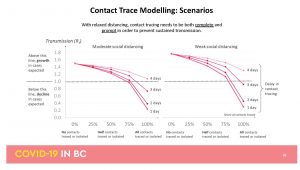 Image: Importance of contact tracing on keeping transmission low.
Image: Importance of contact tracing on keeping transmission low.
Layers of protection (ie. “control measures” such distancing, one-way circulation, hand washing, etc.) help keep people safer. If an exposure were to occur, the availability of better information about where a person has been, who they’ve been with, when they were where for how long, etc, also enables more effective and efficient contact tracing to stop the spread. It is therefore possible for larger gatherings with very detailed, accurate information and strong control measures to be safer than smaller ones with no control measures attended by random people who don’t know each other.
This brings us back to the topic of K-12 education. Can schools be chaotic? Certainly. But there are also class schedules, attendance sheets, assigned seating, regulated break times, adult supervision, one-way circulation pathways, hygiene protocols, sanitation standards, mandatory masks in certain situations, strict rules about staying home when sick, and more.
“Learning groups” (or “cohorts”) will also be used to divide schools up into smaller chunks that limit interaction between students that might otherwise occur across an entire school. This is done by providing separated entrances, restricting access to the hallways of other learning groups, staggering break times, and so forth. Learning groups keep students safer while also enabling public health officials to respond to a possible exposure in a way that minimizes disruption to the rest of the school.
Learning groups are not the same as bubbles. Instead, they are controlled groups of students that represent the maximum number of potential interactions a student might have throughout the course of a semester or the year. Students are still required to keep their distance from one another as much as possible and avoid physical contact.
All of these control measures vastly improve safety for students. They also enable public health officers to act quickly in the case of a possible exposure to COVID-19. These well-utilized “layers of protection” in a controlled environment help to compensate for a reduction in the 2m physical distancing recommendation that is normally set for the general public interacting in less controlled environments (i.e. at a store where you don’t know everyone who is shopping at the same time as you). While this may complicate the simple “2m physical distancing” message that has been used to educate public behaviour over the last many months, the return of kids to school is important enough for us to be flexible about how we go about achieving a safe environment.
To help school communities get used to this new way of operating, the first week of school will take a phased approach to allow teachers time to prepare.
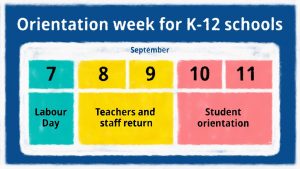
Image: Orientation week for K-12 schools.
September marks the start of Stage 2 of the School Restart Plan. You may recognize Stage 3 and Stage 4 from earlier this year when hybrid models were used more substantially. We are able to be in Stage 2 right now because Dr. Bonnie Henry and her team have affirmed that it is safe to proceed with it. If circumstances change, however, the school system may revert back to Stage 3 (hybrid), 4 (hybrid), or even 5 (remote) as required.
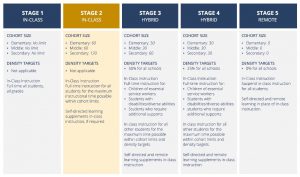 Image: 5 Stages of K-12 Education.
Image: 5 Stages of K-12 Education.
Your feedback continues to be valued.
All of this being said, I recognize that parents will still feel anxious about the return to school in September. It’s okay to feel this way and it’s okay to reach out if you have questions or concerns. Concerned community members are encouraged to share their concerns with their local MLAs and to stay in touch with their school principals as they gear up to welcome students back into classes.
In your service,
Bowinn Ma, MLA
North Vancouver-Lonsdale
Further reading:
- K-12 School Back-to-School Plan: What to expect in September 2020 under Stage 2.
- K-12 Restart Plan: What the 5 stages are and how they differ.
- PHO Guidance: Public Health Officer guidance letter.
